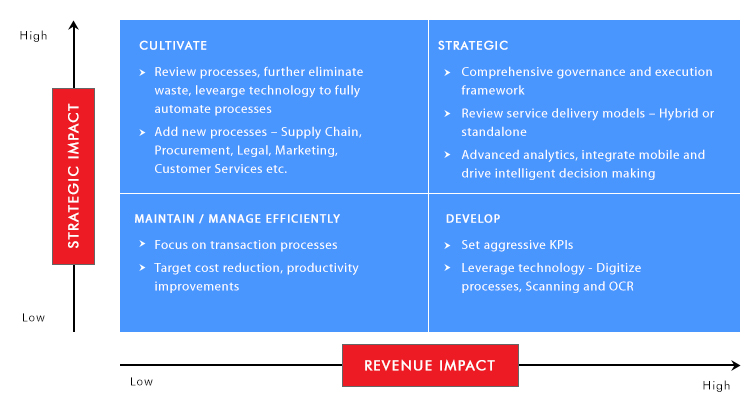COVER STORY OF THE MONTH

The Next Generation Shared Services Organization
Shared services (SSC’s) has been in existence since the 1980’s. They have demonstrated cost efficiencies, productivity improvements and enhanced effectiveness for organizations for quite some time now.
However over the last few years, the whole concept of shared services is undergoing a re-think in most organizations. Today’s enterprises are looking to leverage shared services in a completely strategic way to deliver their bottom line results.
Several SSC’s are reinventing to consider a hybrid model (of captive centres vs. outsourcing), covering customer experience, analytics and operational excellence in addition to transactional processes, governance structure and process excellence with the help of digital technologies.
In a survey with over 500+ large enterprises, what is interesting is that many still believe that there are significant opportunities to remove “waste” and drive improvement via process standardization and quality improvement. This is no longer just a “ppt-ware” but enterprises are seriously considering responses to why processes need to be the way they are, and how making a difference is going to have an impact to the enterprise goals. They are dealing with eliminating redundant / “business as usual” processes that run the risk of creating rigidity eventually impacting business performance and innovation. The outsourced service provider has traditionally been assessed on metric that does not support in driving innovation or meeting business goals. Enterprises are re-evaluating their performance metric for shared services which were traditionally focused only on cost reduction and spends leading to a set of un-coordinated and disparate processes between disconnected shared services / outsourced vendors.
The Next Generation SSC’s are considering a comprehensive governance framework that supports in ensuring interfaces, eliminating silos, that makes the shared service work seamlessly and ensure scalability, irrespective of whether they are captive or have been outsourced and allows the company to meet its financial objectives. With clear roles and responsibilities between the provider and the customer, the governance framework becomes the foundation for keeping track of service delivery, quality and costs.
The scope of shared services is being expanded to look beyond Finance, HR and IT. Procurement, Supply Chain, Legal, Marketing, Customer Services and Operation functions are being evaluated to explore ways to increase competitiveness and enable the organization to meet its financial objectives while also driving innovation. Enterprises are leveraging digital technologies that allows them to significantly drive speed and accuracy in running their shared services processes and make additional time available for better decision making by providing dashboards on key performance indicators including process agility and service innovation. Integrating mobile not only allows faster transaction processing but also quick decision making. By leveraging insights from massive volumes of both structured and unstructured data, SSC’s can be the core engine that drives intelligent decision making for the organization. Portals provide a collaborative access to all SSC services both within and outside the organization. Automating workflows not only expedites processes but also allows audit trails that are much required ensuring compliance. Digitization, OCR and Document Management solution enables to get rid of paper processes and supports in real time reporting. The next generation SSC’s consider themselves a transformation factory focusing on leveraging technology to enrich customer experience, re-envisioning operational processes and taking advantage of existing valuable strategic assets in newer ways.
Perhaps one of the most significant factors for the success of the SSC is managing change. Best in class SSC’s adequately invest in preparing the organization to make a significant shift in the way they operate. The governance team together with the PMO, take charge of determining the challenges, gaps and risks of such a change and proactively plan to address these readiness challenges while putting together an execution framework. A well-designed communication plan is extremely critical to ensure that the stakeholders in this process understand and are party to the strategic intent behind the change, and perceive its success as their own. Any perceived threats to the workforce resulting from this change should be taken head-on to build an element of trust and promote transparency.
In an era of eliminating waste and doing more with less, the question of shared services is not about whether or not, but rather “when” and “how”. Shared services can become the core backbone for an Enterprise’s goals relating to agility and innovation by moving up the value chain both in terms of processes covered as well as on how they cover them by leveraging new business models combined with digital technology.















